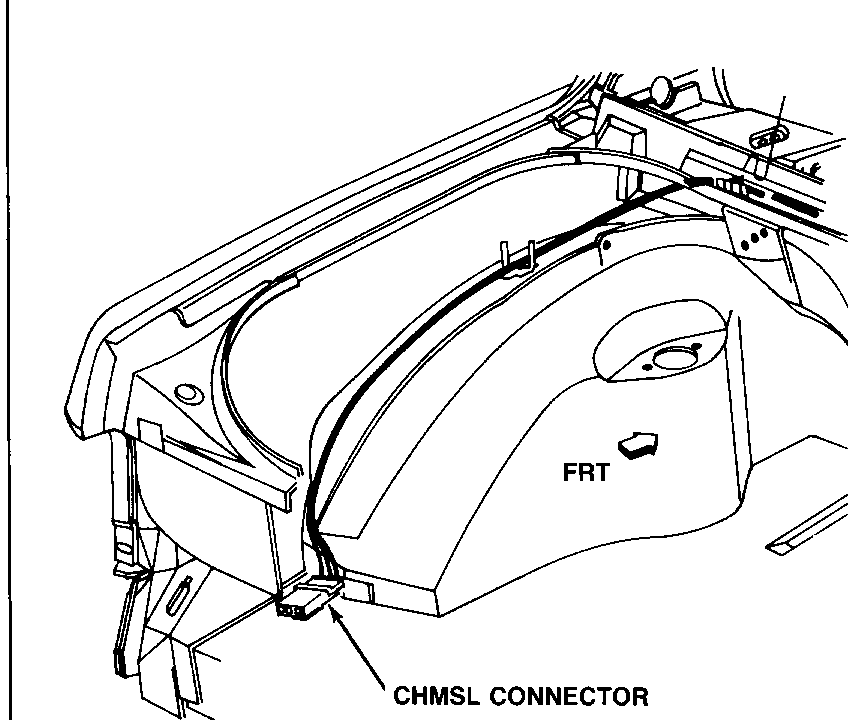HIGH MOUNT BRAKE LIGHT INOP. TERMINAL MISPOSITIONED

CENTER HIGH MOUNTED STOP LAW WIRING HARNESS TERMINALS MISPOSITIONED
MODELS/YEARS: 1986 CUTLASS CIERA MODELS EQUIPPED WITH OPERA LAMPS (OPTION C93) AND TRUNK LID LUGGAGE RACK OPTION V56
CONDITION
General Motors has determined that certain 1986 Oldsmobile Cutlass Ciera models fail to conform to the requirements of Federal Motor Vehicle Safety Standard (FMVSS) 108; "Lamps, Reflective Devices and Associated Equipment." The above referenced vehicles equipped with luggage rack and opera lamp options may have an incorrectly indexed wiring harness. This condition may cause the opera lamps to come on when the brakes are applied and the center high mounted stop lamp (CHMSL) to remain illuminated when the head lamps or parking lamps are on. FMVSS 108 requires that the center high mounted stop lamp be lighted only when the brakes are applied.
VEHICLES INVOLVED
Involved are certain 1986 Cutlass Ciera models equipped with opera lamps (option C93) and trunk lid luggage rack (option V56N58) within and including the following vehicle serial number:
Assembly Plant Beginning Up To And Including -------------- --------- ------------------- Doraville (D) GD300003 GD334176
DEALER ACTION
To correct this condition dealers are to correctly index the center high mounted stop lamp (CHMSL) wiring harness terminals on affected vehicles as described in the service procedure section of this bulletin.
Dealers are to service all vehicles subject to this campaign at no charge to owners, regardless of mileage, age of vehicle, or ownership, from this time forward.
Whenever a vehicle subject to this campaign is taken into your now or used vehicle inventory, or it is in your dealership for service in the future, you should take the stops necessary to be sure the campaign correction has been made before reselling or releasing the vehicle.
This bulletin is notice that the now motor vehicles included in this campaign may not comply with the standard identified above. Under Section 108 of the National Traffic and Motor Vehicle Safety Act, it is illegal for a dealer to sell a new motor vehicle which the dealer knows does not comply with an applicable Federal Motor Vehicle Safety Standard. As a consequence, if you sell any of these motor vehicles without first performing the campaign correction, your dealership may be subject to a civil penalty up to $1,000 for each such sale.
SERVICE PROCEDURE
1. Disconnect negative battery cable.
2. Open trunk lid and locate connector at left rear of trunk. Refer to illustration.
3. Disconnect CHMSL harness connector from main body harness. Remove terminals from CHMSL connector.
4. Reinstall connectors in proper cavity:
Cavity A - Black Wire Cavity B - Brown Wire Cavity C - Lt. Blue W/Double Black Strips Wire
5. Reconnect CHMSL harness to main body harness.
6. Reconnect negative battery cable.
7. Test CHMSL for proper operation.
8. Install Campaign Identification Label per instructions in this bulletin.
CAMPAIGN IDENTIFICATION LABEL INSTALLATION
Each vehicle modified in accordance with the instructions outlined in this procedure will require a Campaign Identification label. Each label provides a space to include the campaign number, the five (5) digit dealer code of the dealer performing the campaign service, and the date the vehicles was campaigned. This information may be inserted with a typewriter or ballpoint pen. When installing label, clean the surface of the radiator upper mounting support and apply the campaign label where it is readily visible.
PARTS INFORMATION
It will not be necessary to order parts to perform this campaign correction.
CLAIM INFORMATION
Operation Failure Code Labor Operation Labor Hours --------- ------------ --------------- ----------- Correctly index 96 V3311 .2 CHMSL Wiring Harness Terminals And Inspect For Proper Operation.
.1 hour for clerical administration may be added to the above operation.

General Motors bulletins are intended for use by professional technicians, not a "do-it-yourselfer". They are written to inform those technicians of conditions that may occur on some vehicles, or to provide information that could assist in the proper service of a vehicle. Properly trained technicians have the equipment, tools, safety instructions and know-how to do a job properly and safely. If a condition is described, do not assume that the bulletin applies to your vehicle, or that your vehicle will have that condition. See a General Motors dealer servicing your brand of General Motors vehicle for information on whether your vehicle may benefit from the information.
